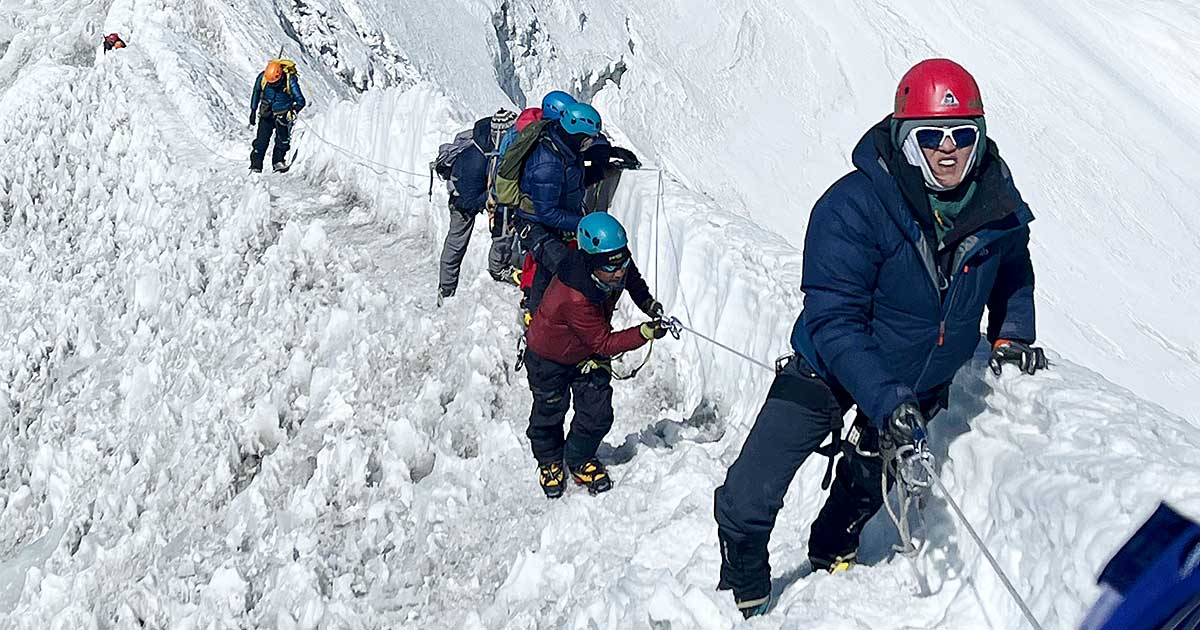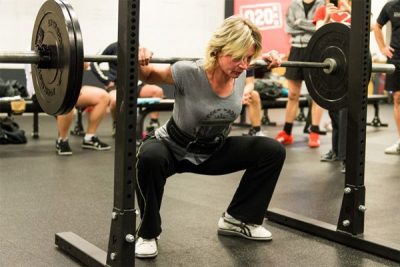
In September of 2023 our gym, Axistence Athletics, hosted an All-Terrain Conditioning™ seminar taught by StrongFirst Certified Master Instructor Derek Toshner and StrongFirst Certified Team Leader Kenneth Bolyard. Walking into the gym I was surprised to see Jin, one of our gym members. I was only expecting to see our coaching staff, who enjoy nerding out on sets, reps, and percentages. However, after just a few minutes of talking with Jin, I quickly understood. Jin had signed up to climb Island Peak in April of 2024. Island Peak is a 20,226-foot mountain located in the Nepalese Himalayan Mountain range. In fact, she was not only going to climb this peak, but she was going to undertake twenty days of hiking at 14,000-18,000 feet in elevation, including a day trip to Mount Everest’s base camp.
Simply setting this goal was courageous and inspirational, but Jin was driven by something more than just accomplishing a physical feat. Twenty-seven years ago, Jin and her husband were in a plane crash. She survived. He did not. Out of 254 passengers, only she and 24 others survived. Living with the burden of surviving weighed heavily on her for a long time. Her healing began when she started climbing mountains. The first time she summited a peak and was above the clouds, she felt she was seeing the world for those who did not survive. Instead of viewing survival as a curse, she became driven to honor the memory of those who died by appreciating the life she was given. What better way to do that, than climbing high mountains? Taking on this 20,226-foot climb held a deep purpose for her, and it was her physical and mental strength that helped her accomplish this goal.
The Program
About a week after the seminar, Jin reached out to me and asked if I would help write her a program based on what we had learned at the All-Terrain Conditioning™ seminar. After looking through the manual, I decided to start with the Heart Rate Step-Up Plan 2053. This plan is designed to prepare athletes for outdoor activities that involve vertical gain and loss. It specifically improves leg strength, overall endurance, and mental fortitude. As those who have climbed mountains before will know, the challenge is mental as well as physical. Following a plan that trained mental strength was just as important as improving physical strength.
Jin already had a good base level of strength, having been a member at our gym for about six years. She was also not new to mountaineering and had already climbed a few mountains (although none above 20,000 ft).
We broke the training down into two 6-week cycles. In January, she was planning to climb Pico de Orizaba, which is the highest volcano in North America standing at 18,491 feet about sea level. This would be a practice climb before her trip to Nepal. The first six weeks would lead up to her climb in Mexico, including a peaking phase. Then when she returned, we would have six more weeks before her climb in April.

We started by calculating her max heart rate (MHR) using the formula below. You can find this equation in the All-Terrain Conditioning™ manual. This one is specifically for women.
MHR = 216 – (1.09 x Age)
Then using the All-Terrain Conditioning™ manual as a guide, I programmed two days of loaded step-ups and one light carry day for her. In order to determine the volume (time) and intensity (load), I rolled a die.
The volume was either 30min, 45min, 60min, or 75min depending on the die roll.
Intensity was either 10%, 15%, or 20% of bodyweight depending on the die roll.
The light carry day was 30 minutes with an 8kg kettlebell with the goal of not setting it down.
Plan 2053 requires the athlete to maintain a constant heart rate between 65%-75%. Jin’s target heart rate (HR) fell between 110-120 beats per minute (bpm). If her HR spiked during step-ups, she would pause until it came back down and then she would begin again.

Please see the table below for a three-week snapshot of her first cycle.

She followed this format for 6 weeks. Here is a page from her training log that shows her progression for 30-minute step-up sessions with a load of 15 pounds.

During the two weeks leading up to Mexico, I wrote Jin a peaking protocol (found in the All-Terrain Conditioning™ manual). During these sessions Jin pushed herself, monitoring her HR. Although the intent was to increase her HR it was still not to exceed 88% of her MHR.
In mid-January, Jin climbed Pico de Orizaba. Although she did not summit due to a time limit, she felt strong and was encouraged to continue her training when she returned to Denver.
Leading up to Nepal
After she returned, we followed the same format, but no longer did the light carry day. Instead, she attended group classes at Axistence Athletics two days a week. She used this for additional conditioning still monitoring her heart and ensuring she didn’t spike it above 70% of her MHR.
In March 2024, the month before she left for Nepal, she compared one of her step-up sessions to one she had completed in November 2023. See her results in the table below.

All-Terrain Conditioning™ seminar:
Charleston, SC—online & virtual—September 14-15, 2024
San Diego, CA—online & virtual—October 26-27, 2024
Sign up today and power to you!
Peaking
A few weeks before Jin left for Nepal, I wrote her a peaking protocol similar to the one she completed leading up to her climb in Mexico. The peaking session consisted of repeats of 264 steps and 6:00 minute rest periods with the heart rate not to exceed 88% MHR. She was able to compare the results of a peaking session leading up to Mexico to one leading up to Nepal (about 3 months apart). Before her trip to Mexico, she could barely complete two rounds with 20 pounds. The month before her climb in Nepal she completed 7 rounds with the same load. Also significant was the difference in her heart rate. In the peaking session before Mexico, it climbed over 150 bpm at times, but during her session leading up to Nepal it never went above 135 bpm.
The Climb to Island Peak
The climb and summit of Island Peak was planned for day 14 of the trek. The day started around midnight because it was important to summit before 12pm due to weather conditions. Her pack was a bit heavier because they needed to bring crampons and some extra gear to the summit. Jin said she could only hear her breath and the sound of her feet moving one in front of the other (kind of like step-up training). The total trek from the Island Peak base camp was 7.5 miles, but that included a steep gain in elevation as well as roping in to scale a glacier. There were times the guide checked in and asked Jin if she wanted to turn around. But she was determined. She had prepared for this physically and mentally. Jin kept going and after 10 hours of climbing, she reached the summit and stood on top of Island Peak at 20,600ft.
Conclusion
After reflecting on her training and accomplishment, Jin’s mindset around training has changed. She learned that consistency, and yes even monotony at times, is what brought her to the summit of Island Peak. She wasn’t always motivated and excited to complete hours of step-ups, but she was dedicated and determined. Jin is in her early fifties and began strength training in her forties. This experience taught her that no matter her age she could get stronger, set new goals, and accomplish things she didn’t think possible. Being strong allowed her to climb a mountain, push herself to her physical limits, and see the world for those who couldn’t. If you are aspiring to complete an outdoor adventure, check out the StrongFirst’s All-Terrain Conditioning™ seminar. Here you will learn specific protocols that include plans from the Strong Endurance™ seminar and Pavel’s book, The Quick and the Dead. I hope Jin’s story inspires you to set goals, make a plan, and work the plan.
Remember, strength has a greater purpose.
Total Training for the Advanced Minimalist








